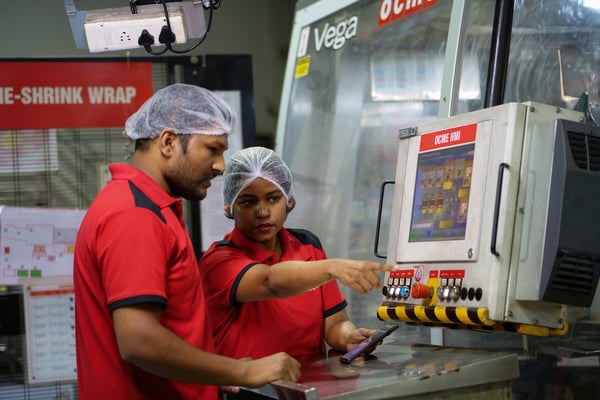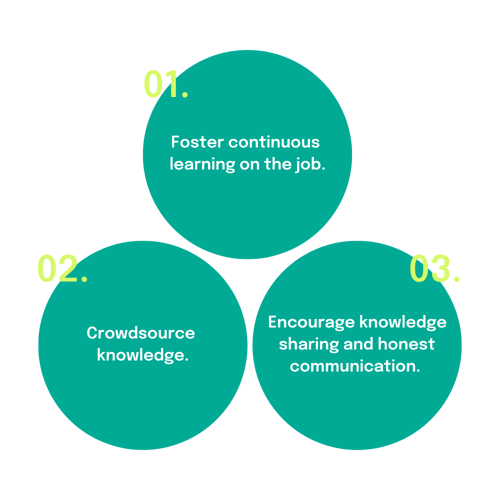Why is training in manufacturing so important?
Out of all industries, manufacturing has seen some of the biggest surges in resignations in the past years - an increase of 58%. Yes, employees are demanding higher pay. But money alone is not enough.
Most employees at the frontline feel disengaged and unhappy in their work. They want a safe and motivating work environment.
One of the most effective ways to drive motivation and uphold safe working practices on the shop floor is to build a scalable program for on-the-job-training in manufacturing that encourages team members to learn while doing.
→ Let's look at how you can build an engaging on-the-job training program that's optimized for frontline teams everywhere.

Frontline training on-the-job: Avoid employee churn.
Why do young people leave their jobs?
- Values and company culture
- Lack of motivation
- No clear development path
- Salary mismatch
Often, frontline team members quit because they have a values mismatch with the organization. Young professionals, in particular, are more likely to prioritize work culture over salary. If they don’t get along with fellow team members or perceive that their personal goals are not aligned with the company’s, they are more likely to leave.
Lack of motivation is also a source of churn. If you take pride in your work, you are less likely to feel disconnected and discouraged. Nothing kills motivation like feeling your voice isn’t heard.
Disengaged team members often underperform in their role; engaged team members stick around and often motivate others. To encourage this kind behavior, train team members to motivate.
On-the-job training vs. classroom training.
Classroom training in manufacturing often uses more traditional training practices like:
- Group lectures
- Discussions
- Textbooks
Here, mastering new skills is based on memorizing and retaining written information that will later be needed on the job.
The problem? It’s not very engaging, and the knowledge tends to be quickly forgotten.
These practices are still essential for a portion of basic onboarding training - but in order to meet the demands of today’s industry, the frontline needs hands-on training solutions where the information really sticks.
On-the-job training in manufacturing and at the frontline uses methods that involve hands-on experience. The employee learns by physically interacting with the subject, rather than memorizing it with abstract concepts from a book.
As new digital tools make independent on-the-job learning a reality, task completion becomes faster and more accurate. Going through step-by-step training at their own pace helps employees get the needed support and answers in real time, retain information easier, upgrade their personal and professional development and feel more confident in their work.

Promote learning-while-doing by delivering the relevant training in the production environment.
An added benefit? It makes them feel valued.
Working for an organization that sees and hears you, and who makes you feel seen and heard, boosts motivation to deliver better results. It makes the employee proud to be a part of the company, and that positively affects overall motivation.
This isn’t everything that on-the-job training has to offer. Here are some other benefits that make this the most effective training method in the workplace:
1. Easy implementation.
Digital job aids can be seamlessly integrated with existing learning management systems (LMS) or other organizational platforms, and are easily accessible for both the management and frontline workers from any device - even a cellphone.
2. Cost and time-efficient training.
Companies with comprehensive employee training programs have 218% higher income per employee than companies without formalized training. It also saves a lot of valuable time, as employees have easy access to all necessary materials along with expert guidance. This allows them to start working as soon as possible, and continue learning along the way to dramatically reduce time-to-serve.
3. Increased productivity.
On-the-job training boosts productivity and proficiency. A Brooking Institute Study found that people in the technical field who receive hands-on experience become more productive than the ones who receive traditional education.
4. Increased employee retention.
Good training and clear standards are proven to increase retention.
When there is no clarity, there is no moving forward. And if there is no moving forward, what’s the point? To get your team up and running, there has to be clear steps and guidance about the task at hand. On-the-job training does exactly that by providing a clear visual breakdown of all the relevant aspects of the work.
Building a culture of learning.
As Peter Drucker once said, “culture eats strategy for breakfast.”
Culture is the glue that binds good teams together. When you institutionalize a learning culture in your organization, employees feel that they can actively contribute to your purpose. They see that you are invested in their growth and are encouraged to perform at their best.
How do you go about building this type of culture?

1. Foster continuous learning on the job.
Standard operating procedures are necessary to uphold quality in every manufacturing plant and they are the hallmark of any continuous improvement process. But SOPs are not useful if they are gathering dust on a shelf.
Continuous improvement starts with continuous learning.
Today, you can implement on-the-job frontline training tools that allow employees to access SOPs and work instructions when they need them most: while performing the task at hand.
Digitizing your SOPs and making them accessible on mobile devices and wearables does not only save time, it increases your team’s performance.
Skills are best honed when you develop them continuously, in practice.
2. Crowdsource knowledge for training on the job.
In every work environment, there’s always something to change and improve. Often, the people who will know problems inside-out are the ones on your frontline.
Crowdsource knowledge from the shop floor to understand what's working and what’s not. Then make improvements in your processes.
Team members who contribute knowledge will feel empowered and involved. It makes them feel valued and reduces the likelihood of churn.
3. Encourage knowledge sharing and honest communication.
It’s important to encourage knowledge sharing between team members as well. Best practices that are only internalized by a small group are scarcely best practices at all. Invite team members to train others on the job.
Start a mentoring program and reward those who drive knowledge sharing. This promotes a sense of belonging and improves collaboration.
Gathering feedback is also important. Encourage employees to share constructive feedback so you can build better processes over time. Having everyone connected and contributing to a process can help drive continuous improvement.
A culture of learning and on-the-job training pays off.
Building a learning culture and empowering employees with the right tools to learn on the job can go a long way. It can help you:
- Retain valued employees.
- Increase productivity and product quality.
- Promote lasting and successful team relationships.
- Lower absenteeism and churn.
- Elevate your employer brand.
Want to learn more?
👉 Smooth frontline training programs
👉 Motivate frontline teams to perform at their best
👉 ZEVx builds a scalable training program with SwipeGuide








